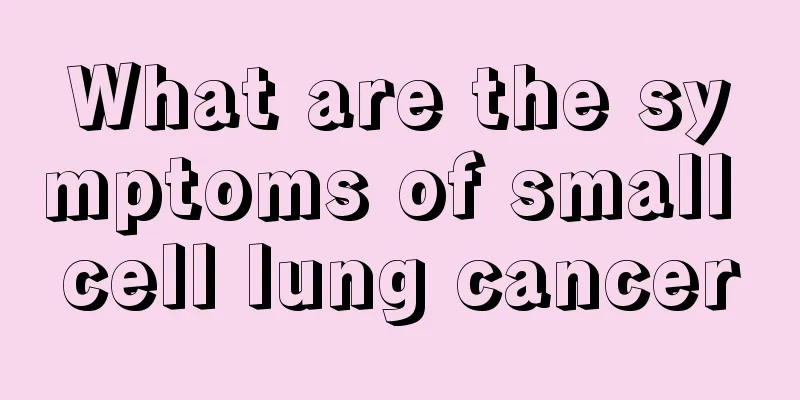What are the symptoms of small cell lung cancer

|
Many patients with lung cancer may not know why they are sick until the last moment of their lives. Although the environment we depend on for survival is not so good, if we can care more about our physical health in normal times, we may avoid lung cancer. Many cases of lung cancer are eventually caused by small cell lung cancer. Knowing more about the symptoms of small cell lung cancer is very helpful for us to prevent lung cancer. Let me introduce the symptoms of small cell lung cancer. symptom 1. Small cell lung cancer may have no symptoms in the early stages! 2. Common symptoms at diagnosis include fatigue (80%), cough (70%), shortness of breath (60%), weight loss (55%), pain (40-50%), and hemoptysis (25%). 1. Symptoms and signs caused by the primary tumor (I) Cough: It is a common early symptom, mostly irritating dry cough. When the tumor causes bronchial stenosis, a persistent, high-pitched metallic cough may occur. Cough is often accompanied by a small amount of mucus sputum, and when secondary infection occurs, it may be combined with purulent sputum. (2) Coughing up blood: Most of the time, there is blood in the sputum or intermittent blood in the sputum. In a few cases, there is severe coughing up blood due to erosion of large blood vessels. (III) Chest tightness and shortness of breath: The tumor causes tracheal stenosis, or the tumor metastasizes to the hilar or mediastinal lymph nodes, and the swollen lymph nodes compress the main bronchi or tracheal carina. 2. Symptoms and signs caused by tumor expansion in the chest cavity (1) Chest pain: The tumor directly invades the pleura, ribs or chest wall, causing varying degrees of chest pain. If the tumor invades the pleura, it will produce irregular dull pain or pain. If the tumor compresses the intercostal nerves, the chest pain may affect their distribution area. (ii) Superior vena cava syndrome: It is mostly caused by compression of the superior vena cava or, less commonly, blockage by a tumor thrombus in the cavity. It manifests as edema of the face, neck, and upper limbs, distended neck veins, congestion in the chest, and varicose veins, and may be accompanied by dizziness, swelling of the head, and headache. (III) Dysphagia: Tumors invade or compress the esophagus, causing dysphagia. (IV) Choking: Choking when drinking water or eating liquid food caused by tracheoesophageal fistula or recurrent laryngeal nerve paralysis (V) Hoarseness: It occurs when the tumor directly compresses or metastasizes to lymph nodes compressing the recurrent laryngeal nerve (mostly on the left side). (VI) Horner syndrome: Lung cancer located at the upper apex of the lung is called Pancoast cancer. When it compresses the C8 and T1 sympathetic nerve trunks, typical Horner syndrome occurs, with ptosis of the eyelid, constricted pupil, enophthalmos, and little or no sweating on the face and chest wall on the same side. When it invades the brachial plexus, local pain and limited shoulder joint movement occur, which is called Pancoast syndrome. (VII) Lung infection: Inflammation that can occur repeatedly in the same area due to tumor blocking the airway is also called obstructive pneumonia. 3. Symptoms and signs caused by extrapulmonary metastasis (i) Metastasis to lymph nodes: Supraclavicular lymph node metastasis is usually fixed and hard in texture. It gradually increases in size, increases in number, and fuses. It is usually painless. (ii) Metastasis to the pleura: causing chest pain and pleural effusion, which is mostly bloody. (III) Metastasis to bones: Most cases are insidious, with only 1/3 having local symptoms, such as pain and pathological fractures. When metastasis to the spine compresses the spinal nerve roots, the pain is persistent and worsens at night. Intraspinal metastasis can rapidly cause irreversible paraplegia syndrome in a short period of time. (IV) Metastasis to the brain: Edema of intracranial lesions may cause intracranial hypertension, resulting in headache, nausea, and vomiting. The space-occupying effect may also lead to diplopia, ataxia, cranial nerve paralysis, weakness of one side of the limbs, and even hemiplegia. (V) Metastasis to the pericardium: Pericardial effusion and even signs of pericardial tamponade may occur, with dyspnea, which is more obvious when lying flat, distended jugular veins, low blood pressure, decreased pulse pressure difference, systemic congestion, and decreased urine output. (V) Metastasis to the adrenal glands, liver, etc., causing dysfunction of local peripheral organs. 4. Extrapulmonary manifestations of tumor and systemic symptoms: Extrapulmonary manifestations of tumor include non-specific systemic symptoms, such as fatigue, anorexia, and weight loss. It also includes paraneoplastic syndromes, the most common of which are: (1) Carcinoid syndrome: Excessive secretion of 5-HT leads to asthma-like dyspnea, paroxysmal tachycardia, watery diarrhea, and skin flushing. (ii) Eaton-Lambert syndrome: a neuromuscular syndrome caused by tumors, including cerebellar cortical degeneration, spinal cord degeneration, peripheral neuropathy, myasthenia gravis and myopathy. (III) Syndrome of inappropriate antidiuretic hormone secretion (SIADHS): manifested by dilutional hyponatremia, poor appetite, nausea, vomiting, fatigue, drowsiness, and even disorientation (IV) Hypertrophic pulmonary osteoarthropathy: It often affects the distal ends of long bones of the upper and lower limbs, causing clubbing of the fingers, pain at the fingertips, and hypertrophic osteoarthropathy. (V) Cushing syndrome: The tumor secretes adrenocorticotropic hormone-like substances, causing fat redistribution, etc. Disease Prognosis 1. The average survival of limited-stage cancer is 12-20 months, and the 5-year survival rate is 10 to 20 percent; 2. The average survival rate in the extensive stage is 7-12 months, and the 5-year survival rate is less than 2%. |
<<: How to quickly and effectively cure small cell lung cancer
>>: What is the cause of small cell lung cancer
Recommend
What are the examination methods for lung cancer? 6 examination methods can confirm lung cancer
Do you know how doctors detect lung cancer? Do yo...
Can I still have sex when I am seven months pregnant?
Some people may have discovered that pregnant wom...
Why do I urinate frequently after bladder cancer surgery
If blood in the stool occurs during intravesical ...
What is Snow Lotus Mushroom? The efficacy and maintenance methods of snow lotus fungus
Snow lotus fungus is a fungus originating from th...
Why do both sides of my neck swell up when I get angry?
Many people cannot control their emotions, and be...
What tests are needed before amniocentesis?
Amniocentesis is actually a method of screening f...
What are the four items of eugenics checked?
For a couple, the biggest dream is to give birth ...
What foods can patients with primary liver cancer eat? Diet therapy and health care methods for primary liver cancer
Regarding cancer diseases, we still cannot simply...
Is a down quilt better or a silk quilt? Here's the difference
Both down quilts and silk quilts have many uses, ...
It is very important to know the early symptoms of nasopharyngeal cancer
Generally speaking, nasopharyngeal carcinoma is a...
The meaning of cupping colors
Cupping is a method of treating physical diseases...
How to deal with a wrist cut
In our daily life, we often come into contact wit...
Has the toothache in late stage of intestinal cancer spread?
Toothache caused by advanced colorectal cancer ma...
How to treat vesicular eczema
In humid and hot seasons, eczema can be said to b...
What's wrong with the left side of my stomach? Female
The structure of women's victory is very comp...









